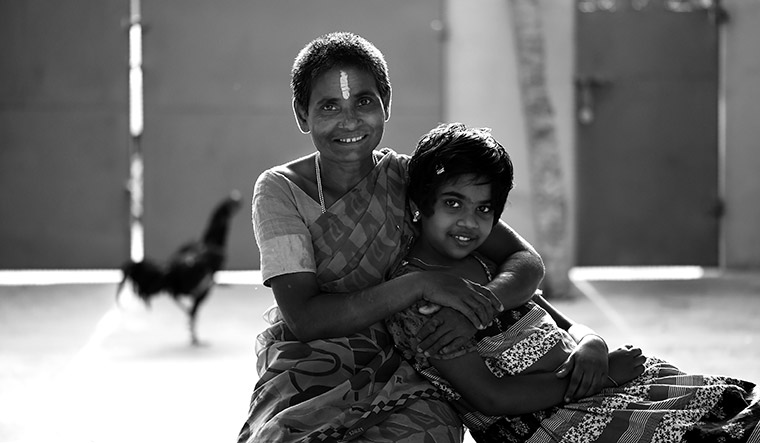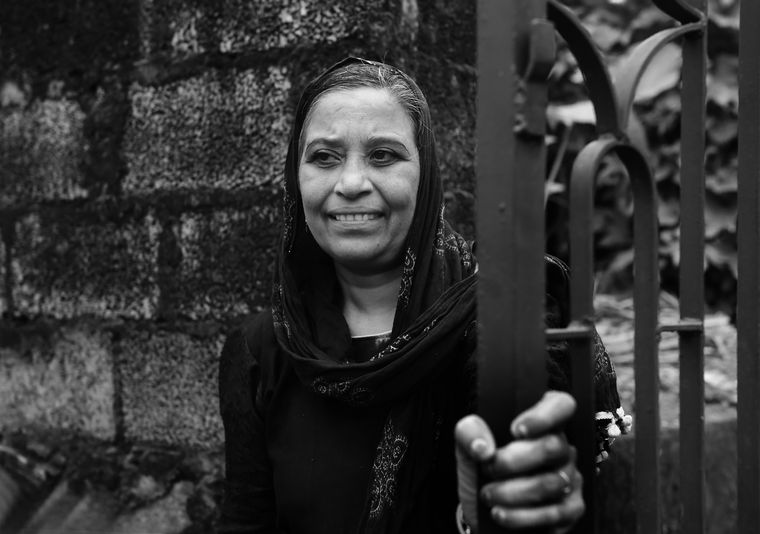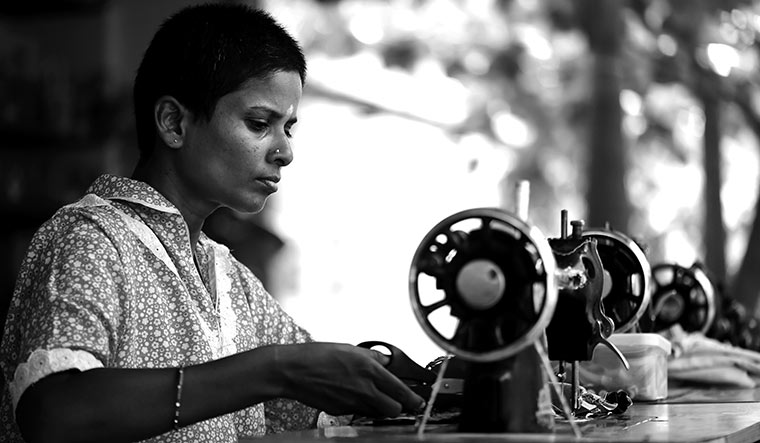VOICES IN MY HEAD
“Madam, are you Priyanka Gandhi?” asks Selvi, a paranoid schizophrenic at Udhavum Ullangal, a home for the homeless mentally ill in Tirupattur, Tamil Nadu. The question would have been comical, except that I have realised that in the world of the insane, everything is serious business. That is why Selvi believes that Sonia and Rahul Gandhi talk with her, and that superstar Rajinikanth is going to stop the voices in her head.
“Someone has changed my mind,” she says, “I want to know why they changed my mind.” Her expression is one of intense concentration, as though she is painstakingly trying to catch up with her thoughts.
There are 137 rescued people at the Tirupattur home, run by C. Ramesh and his wife, Prema. Each of them has their own stories. There is Suresh Singh who has been in the home since 2014. He was found on the street in a dishevelled state, muttering to himself and feeding on garbage. He was carrying a flag and thought he was a soldier. Although the home traced his family, they refused to take him back. “I do patrol work for the railway CBI,” he tells me with conviction.
Then there is another Selvi and her nine-year-old daughter, Dhanushree. Selvi was found around 30 weeks pregnant on the streets of Vaniyambedi 10 years ago. She was diagnosed with formal thought disorder and psychosis. She does not remember her life before she ended up on the street, except for a vague memory of a chicken shed near her mother’s home. Now, her daughter is everything to her. When asked what she wants Dhanushree to become when she grows up, Selvi says: “I only want her to be with me as long as I live.” Dhanushree lives in the women’s home and studies in a convent school nearby. Her favourite pastime is playing kannambochi (hide and seek) with Krishnaveni, one of the residents.
“We started the home in 2006,” says Ramesh. “I figured that there were homes for leprosy-afflicted, the elderly, orphans…. But there were no homes for the homeless mentally ill.”
According to him, the main problem they face is overcrowding. For many years now, they have been turning down requests for admission. Udhavum Ullangal also has to accommodate patients referred by the district mental health department in Ranipet, when the Emergency Care and Recovery Centre (ECRC) run by the department runs out of beds.
Everyone at Udhavum Ullangal has their own demons to fight―of being under the constant government surveillance; of being followed by ‘enemies’; of celebrities wanting to marry them; of having divine powers; of being chosen to ‘protect the border’…. But in another way, their lives have followed similar trajectories. Abandoned by families, lured by the pull of the ‘voices’, left destitute on the streets, rescued by the police or an NGO…. Seen like that, mental illness is an equaliser―it channels its victims’ lives in one direction. It consumes their identity so completely that it is difficult to believe they were once someone’s mother, daughter, son or husband.
THE STREET FIGHTER
A lone, dishevelled woman carrying a four-year-old child wanders around the town of Vellore. It is raining heavily and her sari is drenched, strands of her hair plastered to her face. The child cries relentlessly, but she pays no heed. She wanders mindlessly, aimlessly, perhaps driven by a primeval instinct deep within. A few days later, the child is diagnosed with dengue fever and dies at the government hospital. Her family is inconsolable. The woman, however, does not stay home. Nothing can keep her from the streets. She wanders and wanders….
This is the story of Chinnapulla, who lives in the slums of Vellore’s Old Town, where we go to meet her. The highlight of the slum dwellers’ lives is the two hours daily when they get water. Women make their way to the water pumps holding colourful plastic pots or squat by the roadside washing clothes.
In Chinnapulla’s home, collecting water is her responsibility. She lives with her husband and four daughters in a cramped, one-room tenement roofed with tarpaulin sheets. She wears a bright yellow sari that contrasts with her matted and lifeless hair. “I only took my daughter out because it was raining and our roof was leaking. It was not safe for her to stay inside,” says Chinnapulla, although her husband, Karuna, maintains that the child got sick because she kept taking her out in the cold and the rain.
“Chinnapulla used to be like a rabid dog, often violent, always fighting with us,” says Karuna. “She would never stay home. She would sit by a nearby water tank from morning till night. Initially, we thought she was possessed. We took her to a faith healer who lives near her mother’s home, in the interiors of Tamil Nadu. We thought the rituals would free her, but nothing worked.”
That’s when Karuna approached Christian Medical College and she was admitted in its mental ward. Thrice, she tried to escape by jumping over the wall. Then, the CMC team decided that community-based treatment would be best for her. She was brought back home and prescribed anti-psychotics. Since then, she has shown considerable improvement.
Compared to the other homeless mentally ill people of the country, Chinnapulla is fortunate. At least she has a place to call home and a family who is willing to accept her. Homeless mentally ill people constitute the most vulnerable and marginalised section of society. “Facilities for the rehabilitation of the homeless mentally ill were generally non-existent in many states, and wherever available, were reported to be provided by NGOs often located in bigger cities,” states the National Mental Health Survey 2015-2016. “However, the number of homeless mentally ill being able to access care in these NGOs was reported to be limited. Apart from NGOs, mental hospitals and beggars' homes were the other options available for the rehabilitation of the homeless mentally ill.”
According to Dr Anna Tharyan, former head of department of psychiatry at CMC, there is a dearth of information about homeless people with psychiatric illness. She treated Chinnapulla and cites many factors that result in homelessness among such people.
“Lack of insight, which is an integral part of chronic severe psychiatric conditions, predicts that the sufferer will not seek treatment. Financial constraints and stigma limit the family’s ability to ensure regular consultations and administration of medicines. Paucity of affordable psychiatric services contributes to progressive deterioration of functioning. Planning and policy is impeded by the lack of documentation of the scale, causes and nature of the problem of homelessness. This population will not be captured in a census or survey because of the migratory nature of their lives. Working with the homeless psychiatrically unwell presents multiple challenges. Laws which are meant to protect the rights of people with major psychiatric disorders, can complicate rescue, treatment and rehabilitation. Services for the treatment and care of the homeless mentally ill are grossly inadequate. Chronic psychoses can result in significant levels of dependency. It requires deep understanding and empathy, to say nothing of financial backing and administrative skills, to support people whose brains have been ravaged by disease and neglect.”
For Chinnapulla, the help she received from community workers and the CMC team might have helped keep her mental illness in check, but when it comes to her quality of life, there is much to be desired. The family lives in a fly-infested hut and struggles to make ends meet. Karuna used to roll beedis earlier, but now works in a lodge where he earns 0150 per day. With the money she gets from begging, Chinnapulla meets her own expenses, but does not contribute to household expenses.
“No matter how well mental health services are provided, alone they are insufficient to support the needs of all people, particularly those who are living in poverty, or those without housing, education or a means to generate an income,” states a WHO report on supported living services for mental health. “For this reason, it is essential to ensure that mental health services and social sector services engage and collaborate in a very practical and meaningful way to provide holistic support.”
Mrinalini Ravi, who works with the Banyan, an NGO for the homeless mentally ill headquartered in Chennai, agrees. “The government still has an old-fashioned outlook on mental health that revolves around providing medical support and treatment. But there are so many other issues when it comes to mental health, concerning social mental health, civil society participation, the poverty factor, inclusion issues…. For example, even those who are well enough to work are not able to do so because people are unwilling to employ a ‘mentally unsound’ person.” Ravi says that although many states have provisions for a disability allowance, not many mentally ill patients avail of it, either because they don’t look disabled or because they are too ill to admit that they need help.
TAKE ME HOME
“The eight years I spent at the Kuthiravattom Mental Hospital in Kozhikode were the worst years of my life,” says Jameela, a demure woman whose smile brightens the room. “They never allowed you to take proper bath. They would spray you with a hose. You might or might not get soap. You could never step outside the hospital. If you got violent, they would drag you to the cell, where you were locked up like a prisoner.”
Jameela’s husband used to abuse her. Because of the pain and stress, her thinking became erratic. She left home and tried to kill herself by jumping on the railway track before an approaching train. The police rescued her and brought her to Kuthiravattom. Her daughter, Serena, used to come and visit her at the mental hospital, but she asked her to stop coming because it was too painful to see her. Now, she does not know where her daughter is, whether she is married or has children of her own. “I often wonder what Serena is up to,” says Jameela. “Sometimes I dream of buying a house and staying there with my daughter.”
For the past five years, Jameela has been living with a few other recovered mentally ill women at a home rented by the Banyan Kerala as part of its Home Again initiative. Today, she earns Rs6,000 per month for taking care of an elderly woman at a nearby house. She has saved over Rs1 lakh with which she wants to go on the hajj.
Home Again provides housing and supportive services for people with mental health conditions who have been in long-term institutional care. They either do not want to go home, are unable to trace their families or have been rejected by the families. The service was created in 2015 by the Banyan, and has now served over a million people, with operations in Tamil Nadu, Kerala and Maharashtra. It is the only mental health model from India that has been recognised by the WHO. Under the Home Again initiative, a family or home-like environment is created to enable the residents to mix socially and form connections.
“Even after recovering, people are languishing in mental hospitals for years,” says Salih P.M., who founded the Kerala chapter of the Banyan in 2017. “In 2018, the Banyan officially entered into an MoU with the Department of Health and Family Welfare in Kerala. This allows us to place social workers at the three mental hospitals of Kerala. Through these workers, we help individuals who are fit enough to exit the hospital to join the Home Again programme.”
According to him, the need of the hour in mental health is deinstitutionalising. “None of the government mental hospitals helps the individual reintegrate with her family. If it is a man, the hospital will pay the bus or train fare if he is able to provide his home address. But if it is a woman, they won’t even do that. Women continue to languish in mental hospitals until a family member or a registered NGO rescues them. Even after recovery, people are stuck inside hospitals for 10, 20 or 30 years. As a country, we don’t believe in deinstitutionalising because the existing mental health institutions remain as they are. In order to make the beds free, they sometimes move you from government mental hospitals to private institutions. But this does not make any difference, because the patients are simply moving from one institution to another.”
The impact of long stay on patients in mental hospitals is devastating. Shehnaz, one of the mental health coordinators at the Banyan, recounts how she travelled to Baleswaram in Odisha to reintegrate a mentally ill woman, who had been living in a government mental hospital for 14 years, with her family. They traced her family through the local police station. Twenty-eight years ago, she had married a lower caste man against her family’s wishes. She developed post-partum mental health issues. “I don’t know what happened to her for 14 years before she was brought to the hospital,” says Shehnaz. “Perhaps she was trafficked or abused. When we contacted the village head, he refused to come and pick her up. So, the lady, a volunteer and I called her son from the Baleswaram station. The son, who had been a little over a year old when she last saw him, did not pick up the phone. We did not know what to do. The station master announced our arrival thrice. Finally, a tall lanky lad came forward. The one-year-old boy had turned into a 29-year-old man. The reunion between mother and son was cinematic. They stared at each other, before tears welled up in their eyes. The son now had a son who was his age when his mother had left him.”
Then Shehnaz makes a profound remark: “If only there had been a coordinator then who helped address her mental health needs, she would not have lost 28 years of her life.”





